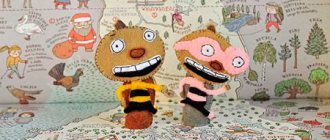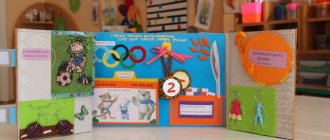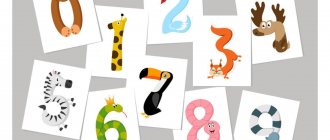Section 1. Games with cards for children: developing imagination
Game "Sorcerer"
This is a game for children from five years old, in the simplest version you can play with children from four years old. The game develops children's imagination, which is very important not only in itself, but also for the development of creative games of preschoolers (plot - role-playing and directing).
The author of the game is E.E. Kravtsova, famous child psychologist.
Preparing for the game: mix cards on different topics in one box. You can also put children's cubes with letters, and pictures from lotto or dominoes on different topics. Close the box. These are our “treasures” that we will take from this box with our eyes closed during the game.
Progress of the game:
First level of the game.
Step 1. Consider with your children a picture of a sorcerer (or a toy - a sorcerer). As a sorcerer toy, you can use the most ordinary plastic water bottle, if you glue the details of the face to it and wrap it in a “magic cloak” - a piece of fabric.
Tell your child a fairy tale about this sorcerer: “Once upon a time there lived a sorcerer in a cave. She knew how to enchant different things: she would enchant them and take them to her cave. But the sorcerer could only enchant those pictures that did not have a pair. If the pictures became pairs, then the sorcerer could not take them.”
Step 2. After this, give the child a box in his hands and ask him to take two cards (two pictures) out of it with his eyes closed. We need to combine these two pictures with one story.
For example, if the picture “snowman” and “basket” appear, then you can imagine that the snowman put gifts in the basket and went to wish his friends a Happy Birthday or Happy New Year. First, come up with such a story yourself based on the pictures that the child pulled out of the box. Then invite your child to come up with his own story based on the new two pictures.
Some children find this game easy, others find it difficult. If it’s difficult for a child to come up with ideas, come up with them first. Offer your child the option: “Where do you think the snowman with the basket went - to the store or to the forest? No? And where to? What did he put in the basket? What would you put in?”
Second level of the game. You can move on to the second level of the game if your child very easily connects two objects (two cards) in one story. Invite your child to take three pictures out of the box first, then four or five pictures. And connect them into one story. If it’s difficult for your child to come up with a story on his own, write it together!
Third level of the game. We need to build a whole chain of 15-20 pictures randomly selected from our box and write a story based on it.
How to play with cards:
We take cards from the box one by one with our eyes closed and compose a common story. For example, you start as an adult. You take a card and come up with the beginning of a story from it: “Once upon a time... And he was very... Once upon a time...”. At this point you interrupt your story and pass the turn to the child. The child takes out the second card and comes up with a continuation. Then it’s your turn again - take the third card and continue our story. And so on up to 15-20 cards. We lay out the cards in a row one after another from left to right. At the end of the stage, the child himself can combine the pictures into a common plot.
Game options:
This game can be played with 2-3 children at the same time, writing a common story. Or you can compete: who has the longest story: a team of mom and dad or a team of children of different ages? The winner of the game is the one who was able to combine the largest number of pictures. .
What you will need to play with cards
For the games in this article, you will need several thematic sets of cards for children with subject pictures (3-5 sets at least). Subject pictures are pictures that depict one object without a plot (for example, a birch tree, a ball, the Sun or a cloud, a cornflower, a dolphin, and so on).
You can make such cards yourself by cutting out subject images from coloring books, magazines, advertising booklets and gluing them onto thick cardboard.
It is desirable that all cards be the same size, but this is not at all necessary.
As mini-cards, you can also use pictures from old board games - lotto and dominoes on different topics (“transport”, “vegetables”, “toys”, etc.)
Section 5. Games with cards for children: development of attention, perception, memory
Game with cards "Chest"
You will need for the game: an opaque box with a lid or a chest (for example, a beautiful cardboard chest from a New Year's candy set).
How to play: show your child 6-10 cards from one thematic set. For example, bird cards. Examine and manure each bird, discuss how they differ from each other and how they are similar. Try to remember what is written on the cards.
Then the child closes his eyes, and you hide three cards in the chest. The child opens his eyes and guesses what kind of cards are in the chest.
In the next game we are changing some of the cards for the game - adding new ones.
If the child guesses easily, then you can hide five cards in the chest.
Game with cards “One, two, three - look carefully”
You will need several paired sets of cards to play. It is necessary that they contain the same objects, but depicted differently. For example, the first set of cards is a photo of pets. The paired second set of cards are drawn images of pets.
How to play. The adult quickly shows a card from his set and says very quickly: “One - two - three - look carefully!” He immediately removes the card. Children need to quickly find a similar picture on the table among the cards laid out in a paired set and name it. The winner is the one who finds it faster among all the pictures laid out on the table.
Game with cards "Concepts"
You will need different themed sets of cards. Place four object pictures in front of your child. Three of them are a homogeneous group and refer to the same concept. The fourth one is redundant. The child needs to find an extra card and remove it, and also explain how to name the remaining pictures in one word and why they can be combined into one group (transport, trees, bushes, migratory birds and other concepts).
Task examples:
- Apple, pear, plum, plate.
— Cup, spoon, fork, glasses.
— Rose, cornflower, chamomile, birch.
Card game "Card Classification"
Place cards from 3-6 sets in front of the child, mixing them with each other.
The task is to look at all the pictures and sort them into groups. Name each group with a word (these are professions, these are vegetables, these are poultry, these are animals of Africa, etc.). After the child combines all the cards into groups, you need to ask him to explain why he put all these pictures in one group and what they have in common.
You can include provocative pictures in the set of pictures for the game - which cannot be classified into any group or combined with other pictures.
Game with cards “What has changed”
Place a row of cards in front of your child. Name them and look at them with your baby. Then let the baby turn away, and you make changes to this row, for example, you can add a picture, or vice versa, remove the picture, swap the pictures in places. When everything is ready, the baby opens his eyes and tries to guess what has changed. Then the adult and child change roles.
Game with cards “Guess the parts”
Place a series of cards in front of your child, for example, cards on the theme “Nomadic Birds”. Look carefully at all the birds - how they are similar, how they differ, how you can recognize them, why they are called “nomadic”. Then the baby turns away, and the adult at this time takes one card and covers it with a thick white sheet of cardboard so that only part of the image is visible. The kid needs to guess what kind of card it is. The remaining cards are closed and not visible.
If it is difficult for a child to guess, then you can slightly open the image so that part of the body, beak, wing or other striking feature of this bird is visible.
The game can be played with any thematic set of cards.
Game with cards for memory development “Help Dunno”
Place 6-7 pairs of pictures related in meaning in front of the child. For example, a fisherman - nets, soap - a washcloth, a hare - a carrot, Santa Claus - a snowflake, and so on. The pictures need to be mixed.
Tell your child that Dunno at school was asked to memorize these items, but he cannot and does not know how to complete this task. The child needs to arrange all the cards in pairs according to their meaning and remember the pairs. Then we cover the cards with a sheet of thick paper or a thick scarf, and the baby tries to name the pairs that he remembers. If he names a pair, then he gets it. We count how many pictures he managed to win from us in this game.
If a child easily remembers 6 pairs of objects, then you can increase the number of pictures in the game.
Game with cards “Invisible hat”
You will need a thick sheet of paper with an invisible hat drawn on it. We put the cards on the table, cover them with a sheet of paper - our “invisible hat”. We lift the sheet with the invisible cap and count to three while showing the cards to the child. Then the invisible cap goes down and the pictures become invisible. The child needs to memorize the cards in three seconds. When the invisible hat covers the cards again, the baby names them.
Game "Restore Order"
You will need 10 cards, place them randomly on the table or floor. Invite your child to remember their location (in 15 - 20 seconds). Then the baby turns away, and the adult swaps the pictures. The child needs to arrange the pictures, restoring order.
Requirements for cards for preschool children
- a realistic, clearly recognizable image (or a large photograph of an object), in which all the details are clearly visible,
- an image angle that is understandable to the child,
- thick cardboard, bright, clear picture printing,
- absence of unnecessary distracting details in the picture.
There are many card manufacturers, but in terms of quality (this is my subjective opinion, of course), I really like the “Little Genius” cards because:
1) they are made on excellent quality cardboard and will last a long time,
2) this series of cards has excellent image quality.
At the end of this article I showed examples of them on various topics.
Also very good quality cards called “Smart Cards”.
As handouts for a group of children, mini-cards on various topics are convenient, which are published by the Sfera publishing house and are called “handout cards.”
Examples of flashcard sets for downloading are given at the end of this article.








